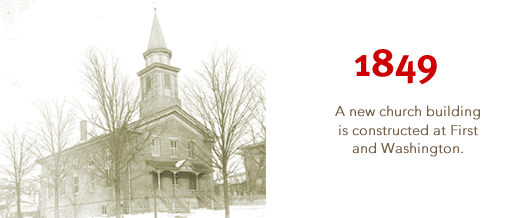Text...
Our Story

The history of Bethlehem United Church of Christ begins with the German Protestant immigration to the Michigan Territory in 1830. Though most of the immigrants accepted the opportunity of hearing the Word of God preached in English churches, they wished to worship their own way, in their own language. So it was that, in January 1833, a letter was written to the Basel Mission House in Switzerland, largely supported by South Germans, asking for them to send a minister to Michigan. Basel Mission House selected a young student by the name of Frederich Schmid.
On August 26, 1833, Pastor Schmid preached his first sermon to 33 families who had gathered in the woods west of Ann Arbor. Thus began Bethlehem Church, the first German Protestant Church in Michigan. The first church home was located in those woods on ground that is now part of Bethlehem Cemetery on Jackson Avenue, just west of I-94. The log cabin served as our church home until June 1849 when the church located in Ann Arbor on the corner of First and Washington Streets.

As the church moved into town, the members felt the need to establish a formal parish school. They believed that “only a parish school with its thorough, systematic religious instruction, stretching over a series of years, can guard the congregation against superficiality and religious ignorance.” The Bethlehem School House was built in 1860 and expanded in 1873. It was located at 436 South First Street.
The parish schoolteacher was also responsible for holding the Sunday School, which began in 1858. In 1872, a Society for Christian Youth was founded and rapidly grew to 50 members. The group met at two-week intervals to debate subjects as: What do we understand by Rationalism? How would we convince a Rationalist, from his position, that it is not nature, but the Eternal God, who is supreme? How can the Rationalist explain the origin of organic and inorganic beings? Members soon became conspicuous by their absence and the group did not last long.

The Women’s Society was organized in 1871. The group flourished for many years, held various fairs, and raised money for a variety of worthy causes, including support of the church. But again, interest began to lag and so the group was reorganized and a new constitution adopted with the following purposes: "mutual edification, mutual assistance, the support of kingdom purposes in general and Bethlehem Church in particular." In 1908, the group had about 200 members.

Because the church was growing beyond the limits of the church home at First and Washington, it was decided to build a new church home. On January 2, 1894, the cornerstone was laid for the current sanctuary portion of our church on Fourth Avenue.
On January 19, 1896, the beautiful sanctuary was dedicated. This was the third building that Bethlehem Church had erected in a span of 63 years. The building was an imposing edifice, surely the most beautiful church building in Ann Arbor, but also a symbol of the sacrificial spirit and of the courageous faith of the congregation.

Worship at Bethlehem gradually changed from German to English, with the pastorates of Samuel John (1903-14), G. A. Neumann (1914-28), and Theodore Schmale (1928-51). Congregations who have never made a language shift cannot appreciate how difficult this was. The differences in language tend to build up divisions within the congregation, and many churches have split because of it. In 1904, Pastor John invited Rev. Jacob Pister, a classmate of his and then pastor of Philippus Church in Cincinnati, to come and speak at a Mission Festival. It was the first time a sermon would be preached in English at Bethlehem.
By 1922, the church council meetings were recorded in English, as were the minutes of the Annual Meeting. Regular services in the German language lasted until 1964. The Ladies Aid, which always conducted its meetings in German, kept its organization intact until the celebration of the centennial of the society in October 1971.
The church continued to grow and additions to the church building were built in 1933 and 1966. Church school classes were large and held concurrently with each of the two Sunday morning services. The 1933 addition to the church included Sunday School classrooms and a gym.

In 1939, the sanctuary was also remodeled and a large wood carving of Thorwaldsen’s Christus entitled “Come Unto Me” was added. Alois Lang, of Oberammergau, Germany did this carving. The 1966 addition included office space, a new chapel, a lounge, youth room, and music room, along with additional Sunday School classrooms. In 1966, additional land was purchased for parking and for a playground area.

In 2003, a new slate roof was installed over the sanctuary portion of the building. This $600,000 project replaced the original roof which dated back to 1895. The congregation was able to use $500,000 from the bequest of Mr. Wolfert Prieskhorn. They raised the additional $100,000.

In 2004, we began a major renovation project for our Casavant Organ. That project was completed in 2006. While the organ work was taking place we also remodeled the sanctuary — the 4th incarnation of our sanctuary in its 110 year history. The chancel area was opened and two rows of pews were removed, making the entire space much more flexible for various presentations during worship and for concerts. Some of the carpet was removed and replaced with oak flooring. Some of the original maple floor was also refinished. By updating both the organ and the chancel, we are better able to meet both the traditional and contemporary worship needs of the congregation.
